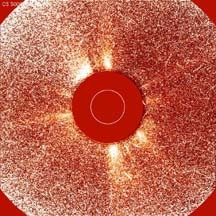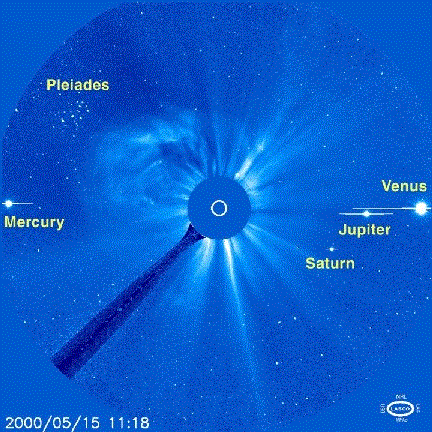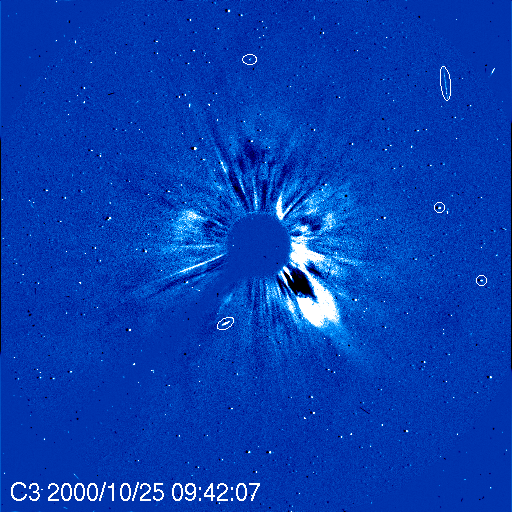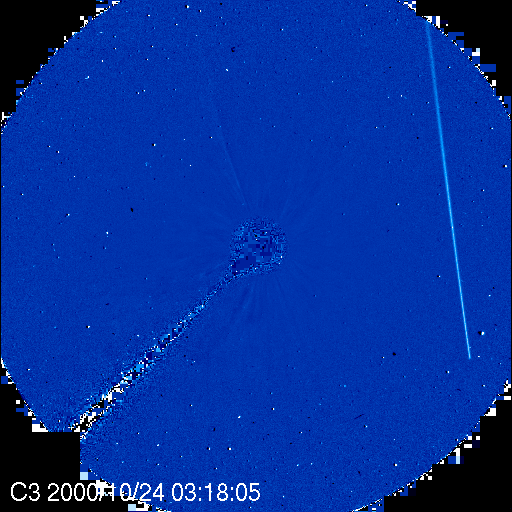INFORMATION TO REPORT AN OBJECT DISCOVERY
We need to know the date, time, and position of the object for at least one image. We also need to know which telescope (e.g. C2, C3) it was observed in and the origin of your coordinate system (e.g. (0,0) in top-left corner). Use the format of past comet discoverers if you are unsure how to make a report.
The object should appear in at least 4 frames to be considered real.
Click here to use a web based tool to measure positions on real-time movies..
Where is the report form?
You might have noticed that there are no SECCHI options on the SOHO sungrazer comet reports form. The primary reason for this is that SECCHI is not going to discover a lot of comets (or asteroids), at least while LASCO is still operational. The addition of reports of SECCHI comets -- the vast majority of which would turn out to be noise or known objects -- would make the reports page even more confusing than it currently is!
So how do I report something?
There are two ways in which you can report a suspected object in SECCHI images, and we recommend you actually do both of these, in this order:
- 1. Send me an email at sungrazer@nrl.navy.mil. Be sure to use a sensible subject line (such as "SECCHI Comet Report") to avoid my spam filters. (See "Reporting SECCHI Comets", below)
- 2. Join the SECCHI/STEREO Comet Hunter Chat Group. This is the best place to submit and view reports of objects in the SECCHI images. The members of this group, much like those in the Soho Hunter group, are very friendly, very helpful and extremely knowledgeable.
Reporting SECCHI comets
If you would like to report a possible comet in SECCHI images, please send an email to me using the following format:
To: sungrazer@nrl.navy.mil
Subject: Potential SECCHI comet
Message body:
Camera and spacecraft (e.g. HI1-A,COR2-B, etc)
Image date(s) (e.g. 2008-09-02, 20080902-20080903, etc)
Your "0,0" position (e.g. (0,0) upper-left)
Image times and x,y positions (e.g. 20:45 123,456)
Your name!
I will reply to your email to confirm receipt, but it may take me some time before I can check your report.
What are the rules for reporting SECCHI comets?
Nobody likes rules but we have to have them. So here they are:
- Objects must be visible in at least FIVE (5) consecutive images
- Objects must have a constant velocity, size and shape with no dramatic changes in brightness over short timescales.
- Objects must obey the laws of physics! That means no disappearing/reappearing, no changing speed, and no changing direction. They must move in a perfect straight line.
- In addition to the pixel positions of the object, I need to know the date and time of the images you are looking at, the orientation of your coordinate system (e.g. is the (0,0) location in the upper-left corner? Or lower-left corner? Somewhere else?), the instrument you are looking at (HI-1, HI2, COR2) and the spacecraft you are looking at (A or B).
- The rules pertaining to discovery credit and such are essentially the same as for SOHO comets but since STEREO comet hunting is new, we can't rule out encountering new problems or a need for new rules. We will have to deal with those as or when we encounter them...
Note that for objects seen in images taken from the L4/L5 campaign, we will lift the restrictions a little because there is only ~6hrs of data at a time. In these cases, just send me all the observations you can for the object. But note that if the object you are reporting is real, then it must be visible in all the available images! If your object suddenly disappears after one or two images, it's probably not a real object...
OK, so where are the images?
You can obtain the latest SECCHI images from the NRL SECCHI Images website. Note that on that site, we resize the COR2 images down to half-resolution 1024x1024 pixel images. The HI images are also at 1024x1024 size, which is the same size at which we downlink them from the spacecraft.
The images on the SECCHI website are scaled for maximum "prettiness", but not necessary maximum contrast. You may find that by applying your own processing to the raw data (FITS file format), you can see fainter objects. Feel free to download the raw FITS images from the STEREO Science Center and process the data yourself. If you make any particulary pretty images, we encourage you to share them with us -- we might use them on our website (and credit you, of course)!
For images taken as part of the L4/L5 campaign, there will be no "pretty picture" images on the NRL SECCHI Website. You will need to download the FITS images from the STEREO Science Center.
Other questions?
Feel free to email the Sungrazer webmaster if you have any questions or comments about anything you have read here.
Common reporting mistakesThere are a variety of common mistakes which inexperienced observers make. They report: |
Object Already Reported.To see what others have reported, please see the recent reports page. |
Stars, Planets, or other Known Objects.
Note: The "rings" (or "wings") seen either side of the planets are not real. They appear because the planets frequently saturate the CCD, causing a bleeding of pixels along a single row. |
Cosmic Ray Noise
|
 A solar flare will heat and eject particles radially outward along open magnetic field lines (called solar energetic particles or solar cosmic rays). Every so often a large flare, positioned so that it is magnetically connected to SOHO, will produce a flood of cosmic rays that will completely blind our CCDs with noise. These somewhat rare events are called "proton storms" and can render our CCD observations useless for days. The lower image on the left shows a LASCO C2 image during a proton storm resulting from the "Bastille Day Event". A solar flare will heat and eject particles radially outward along open magnetic field lines (called solar energetic particles or solar cosmic rays). Every so often a large flare, positioned so that it is magnetically connected to SOHO, will produce a flood of cosmic rays that will completely blind our CCDs with noise. These somewhat rare events are called "proton storms" and can render our CCD observations useless for days. The lower image on the left shows a LASCO C2 image during a proton storm resulting from the "Bastille Day Event". |
Debris Streaks
|

 In every LASCO image you can observe objects whose trajectories are almost exactly horizontal. The majority of these objects are stars. (The rest being very occasional planets and asteroids.) Every C3 image has approximately 200-300 visible stars and every C2 image has approximately 10-30 stars visible. Stars will always move from left-to-right (due to SOHO's orbit about the Sun) at a speed of a few pixels/hour. Occasionally, planets appear in LASCO images and they, too, have a nearly horizontal motion. However, planets can move left or right through the field-of-view and can be faster or slower than the background stars. A list of expected planetary transits is provided at the 'C3 Transits' link. This link also provides dates of expected asteroid appearances in LASCO images. Overall, if you believe you have discovered a comet and its motion is nearly horizontal, chances are you've actually located a star, planet, or asteroid. Check the 'C3 Transits' link for known objects or use an ephemeris program to identify known stars, planets, asteroids,or comets. Click on the image below to see examples of stars and planets visible in a LASCO image.
In every LASCO image you can observe objects whose trajectories are almost exactly horizontal. The majority of these objects are stars. (The rest being very occasional planets and asteroids.) Every C3 image has approximately 200-300 visible stars and every C2 image has approximately 10-30 stars visible. Stars will always move from left-to-right (due to SOHO's orbit about the Sun) at a speed of a few pixels/hour. Occasionally, planets appear in LASCO images and they, too, have a nearly horizontal motion. However, planets can move left or right through the field-of-view and can be faster or slower than the background stars. A list of expected planetary transits is provided at the 'C3 Transits' link. This link also provides dates of expected asteroid appearances in LASCO images. Overall, if you believe you have discovered a comet and its motion is nearly horizontal, chances are you've actually located a star, planet, or asteroid. Check the 'C3 Transits' link for known objects or use an ephemeris program to identify known stars, planets, asteroids,or comets. Click on the image below to see examples of stars and planets visible in a LASCO image. Cosmic rays are very high energy particles which come from a variety of sources (e.g. solar flares, supernovae). They are of interest to lots of astronomers, but mostly just noise for us. We see lots of them in every image and occasionally, 3 or 4 of them hit the CCD in just the right places in consecutive images to fool us into believing there is a real object there. The cosmic rays can show up as points or as streaks. (
Cosmic rays are very high energy particles which come from a variety of sources (e.g. solar flares, supernovae). They are of interest to lots of astronomers, but mostly just noise for us. We see lots of them in every image and occasionally, 3 or 4 of them hit the CCD in just the right places in consecutive images to fool us into believing there is a real object there. The cosmic rays can show up as points or as streaks. ( Debris can refer to astronomical or human-made debris. The debris may be dust or spacecraft insulation which has flaked off. Visit
Debris can refer to astronomical or human-made debris. The debris may be dust or spacecraft insulation which has flaked off. Visit